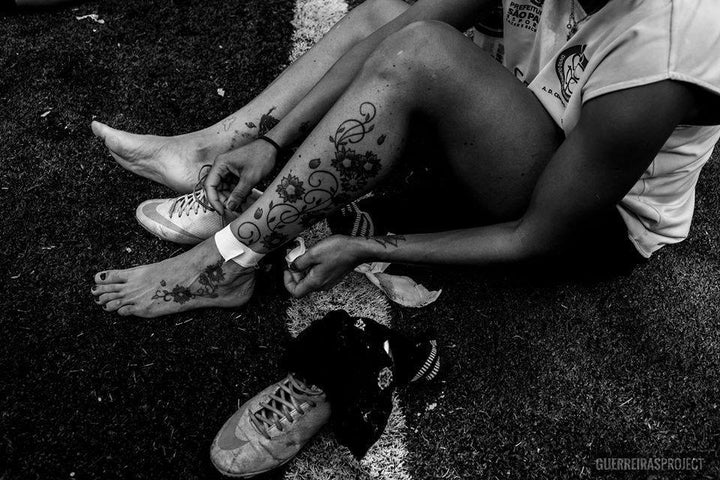
The 2016 Rio Olympic Games have hardly begun, and some news were already framed by the online feminist intelligentsia – namely, news in which images of the athletes’ bodies are composed so as to sexualize them.
Praising Olympic athletes for their good shape is redundant (they are, after all, the world’s sporting elite), but it is also pernicious. This is because the language and images used as fodder for these news pieces rarely celebrate the power of these women´s bodies, nor the skills that have turned them into champions, like discipline and obstinacy. Nonetheless, details about things like the shape of their bottoms abound. An athlete’s good form, which serves different purposes, by the hands of what can be better described as randy journalism becomes yet another device to putting women where patriarchy wants us: as decorative complements and objects of desire, not autonomous agents whose success is due to our own efforts.
This may come across as old news – after all, we have been hearing it in different sporting (and non-sporting) contexts time and again. Questions about the objectified representation and portrayal of female athletes were present in the discourse around many previous mega-sporting events, in terms of media coverage, over the past decade. That we are still talking about it, or talking about it again, is a sign that old sexist media habits die hard… in Brazil and everywhere else.
Before progressing with this article, I am going to make a confession: I don’t practice sports. Still, I shall keep writing about the Olympics. The reason I choose to declare that I am not athletic, before making a feminist critique of the Games, is this: I know that the lives of female athletes – amateur or professional – are much more directly, dramatically and adversely affected by misogynist sporting practices than those of people who, like myself, follow the sports media only during big fat events like the Olympics.
The outlook I aim to offer here is that of a feminist spectator, both of the games themselves and of all the media coverage that follows. A look that anticipates what will certainly happen during the transmission of #Rio2016: the objectification of the athletes by said randy journalism, which abuses their bodies, even if symbolically. My focus is centered on Brazilian media, but we all know well that this type of journalism and these depictions are prevalent in all corners of the world and will be echoing internationally during the coming weeks.
Before I started writing this article, I was in two hearts about questioning the Olympic apparatus and celebrating the athletes. As soon as I started, though, I realized: celebrating the achievements and glories of women athletes in a respectful manner, avoiding the trap that turns these professionals into “muses” for male consumption, is to question the Olympic apparatus – or at least the chauvinistic structures still supporting it.
It is not difficult to celebrate athletes for their skills, and not for their looks. This is already the treatment we grant male athletes with. That we need to write, launch campaigns, or produce educational material so that the media does not treat athletes as sex objects is evidence of the latent sexism that permeates all institutions. Great that these campaigns are raising awareness, but we should not be absorbing them at face value; rather, we should be asking ourselves why the need for them remains as pertinent as ever.
Machismo is one of the main reasons why women turn away from sports, and the symbolism of giving women athletes the “hot chick” treatment reinforces a message that has been sent to women forever: your [athletic] ability is second class, what really matters is how you look. This is the same message sent to girls and women everywhere, about almost everything, and every day: “your role is merely decorative”. An inequality is so internalized that when the athletes point it out, they are often discredited, or even silenced.
The randy journalism that treats athletes as mere sexual objects is very much responsible for the great dilemma of female sports professionals: do they get lower coverage because they get less money, or do they get less money because they get lower coverage? It is impossible to answer this question without first understanding that, in order to conquer material equity, first we need subjective equity, and for that to happen it is critical that we respect and admire these athletes primarily for their work, and not her thighs or breasts.
There are some steps in a positive direction that should be highlighted, though. For one, there are many feminist projects that have sprung up over the last decade in Brazil which are dedicated to questioning and challenging this paradigm.
Olga Esporte Clube, for example, aims to transform the relationship between women and sports on the assumption that machismo robs us from the right to pleasure, socialization and personal growth, which are the essence of practicing sports (I hear). It is machismo that which makes sports and women´s athletic inclination into instruments of control, especially of bodies, by way of promoting neuroses such as weight control and fixation on aesthetic perfection.
Guerreiras Project has been using football as a tool to reveal, analyze and combat gender bias for years. This initiative (which I happen to be a co-founder of, along with former US player Caitlin Fisher and Aline Pellegrino, champion of the 2007 Pan American Games, runner-up of the Women’s World Cup 2007, and a silver medal in the Olympic Games 2004) creates and encourages dialogue aimed at increasing awareness and the critical reflection necessary for the removal of sexist obstacles from the paths of athletes.
Dibradoras – whose work also raises awareness about the blatant sexism that runs through women’s football – tired of watching the media treat professionals who work hard to be champions with a lot of training, sweat and tears as “muses”, launched the campaign #MaisQueMusas (#MoreThanMuses), begging for a more mature journalistic coverage of the athletes, hoping to sweep away the teenage transmission typical of randy journalists, whose sole interest appears to be gazing upon sexualized female bodies.
Revista AzMina have published the didactic guide, “How to not be sexist in sporting contexts”. In it, practical tips for journalists, athletes, coaches and spectators remind everyone that women do not exist, nor exercise, to seduce men or to be their muses, but rather because women are human beings who love sports and play sports, and shouldn’t be disregarded and objectified, let alone suffer violence on account of it.
Additionally, some national media outlets have already taken steps to ensure that misogyny is done away with in their Olympics coverage. UOL Esporte sought help from two feminist-centric Brazilian NGOs – AzMina and Think Olga – to map the barriers that female athletes face because they are women. With five videos and a series of reports leading up to the Olympics, the campaign encourages all women to join forces in denouncing the sexism that pervades these athletes’ lives by using the hashtag #QueroTreinarEmPaz (#IWantToPracticeInPeace). Bravo.
In the meantime, journalists – as well as fans, executives, families and coaches – should not remain comfortable with sexist coverage of female athletes. #Rio2016 should also serve as an opportunity for us, spectators, to keep talking, even if it sounds repetitive in certain corners, and challenging oppressive norms and standards that are still socially accepted, and constantly reproduced. It is no longer acceptable that serious and highly qualified female athletes be reduced by the media to “someone who looks very hot”.
#TemMulherNaJogada (#ThereAreWomenPlayers), so pray that the audience keep an eye out for randy journalism, and denounce it by using hashtags, among other tools and tactics, that will inevitably reach the mainstream misogynistic media. Let campaign, talk and hashtag away, until this puerile journalism grows some… shame and starts to act like grownups. Preferably not sexist grownups.
